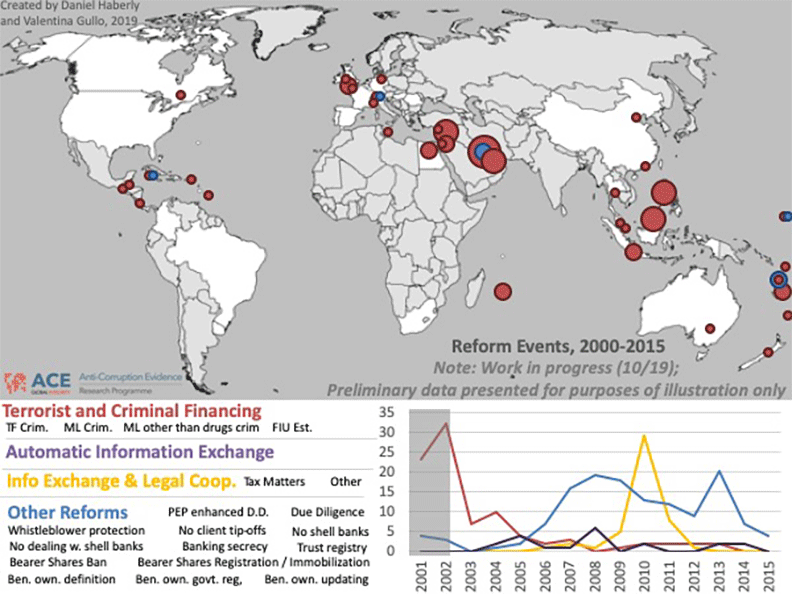by Daniel Haberly and Valentina Gullo
On September 26, our GI-ACE project ran its first workshop, “Dark Architectures: Advancing Research on Global Wealth Chains.” Jointly hosted by the Centre for the Study of Corruption and the Tax Justice Network, this workshop brought together members of four different GI-ACE research teams and a number of other experts in the areas of anti-corruption and offshore jurisdiction / tax haven research.
The goal of the workshop was to provide an opportunity for participants to share insights and challenges from their own experience and work, to help to advance one another’s research. From the standpoint of our own project, it gave us an opportunity to present in detail on the preliminary version of the historical financial secrecy database that we have compiled over the past several months, which (along with the International Consortium of Investigative Journalists (ICIJ) leaked databases) will form the primary foundation for our project’s data analysis.
The animated map above provides a preliminary overview of how the world map (in 61 jurisdictions) of secrecy-related regulation evolved between the years of 2000-2015. To help to extract key trends from complex patterns, the visualization makes use of time-series factor analysis to highlight (color-coded) waves of correlated “reform events” (defined as years in which a jurisdiction improves in the score that we assign to it for a particular regulatory indicator). While we are still filling in a few gaps in missing data, as well as adjusting and checking various elements of the classification procedure (and results generally), a few general developments are nevertheless clearly visible:
- The period immediately after the turn of the millennium witnessed a widespread wave of basic regulatory reforms and capacity building in the areas of terrorist and criminal finance (red) in the wake of the September 11 attacks (and also building on international regulatory initiatives already ongoing since the 1990s). Geographically, these reforms were disproportionately concentrated in countries with a high-risk of Islamist terrorist financing, with Bahrain, Lebanon, the UAE, Brunei, the Philippines, Indonesia, Jordan, and Egypt all featuring prominently.
- From roughly 2003-2005, there was something of a global lull in reforms, with the exception of the implementation of automatic exchange of information (purple) in and between a number of jurisdictions linked largely to the EU Savings Directive.
- From roughly 2006 onwards, a far-reaching wave of regulatory changes across a large number of areas ranging from banking secrecy to client due diligence (blue) began to mount in both intensity and geographic scope.
- This reform wave appears to have peaked in roughly 2008, with a significant spike also visible in 2013. It is important to note that we are still filling in some gaps in data near the end of the time series for jurisdictions whose most recent Financial Action Task Force Mutual Evaluation Report was before 2015, which means that the extent of reforms toward the end of the time series might be slightly underestimated.
- Notably, in the midst of this reform wave, between the years of 2009 and 2011, a much more temporally concentrated spike in reform events in the specific areas of information exchange and cooperation (yellow) can be seen rapidly spreading across the map. This period witnessed key developments including the amendment of the OECD Convention of Mutual Assistance on Tax Matters (2010), and a rapid expansion of the international network of bilateral Tax Information Exchange Agreements between offshore and onshore jurisdictions.
As noted above, we currently are in the final stages of completing the historical financial secrecy database and, as such, the picture shown here is a preliminary one whose details will evolve as our project progresses.
We would like to extend a particular thanks to the participants* of our first project workshop, as well as the Tax Justice Network’s Financial Secrecy Index team, for their helpful advice and comments on this undertaking, many of which we are in the process of incorporating into the database. We also welcome any comments or questions based on the preliminary data shown in the animated map above.
- Robert Barrington – Centre for the Study of Corruption, University of Sussex
- Elizabeth David-Barrett – Centre for the Study of Corruption, University of Sussex; GI-ACE Principal Investigator
- Paul Gilbert – School of Global Studies, University of Sussex
- Jackie Harvey – Newcastle Business School, Northumbria University; GI-ACE Principal Investigator
- Susan Hawley – Spotlight on Corruption
- Martin Hearson – International Centre for Tax and Development, University of Sussex
- Paul Heywood – School of Politics and International Relations, University of Nottingham; GI-ACE programme director
- Andres Knobel – Tax Justice Network
- Alice Lépissier – Bren School of Environmental Science and Management, University of Santa Barbara
- Mick Moore – International Centre for Tax and Development, University of Sussex
- Delphine Nougayrède – Columbia Law School
- Miroslav Palanský – Institute of Economic Studies, Charles University of Prague
- Clionadh Raleigh – School of Global Studies, University of Sussex
- Jason Sharman – Department of Politics and International Studies, Cambridge University, GI-ACE researcher
- Peter Sproat – Newcastle Business School, Northumbria University; GI-ACE researcher
- William Vlcek – School of International Relations, University of St. Andrews

Daniel Haberly is a senior lecturer at the University of Sussex. His research and teaching interests cover topics related to economic and financial geography, development, and the organization of global financial networks, with a focus on offshore finance and sovereign wealth fund investment.


